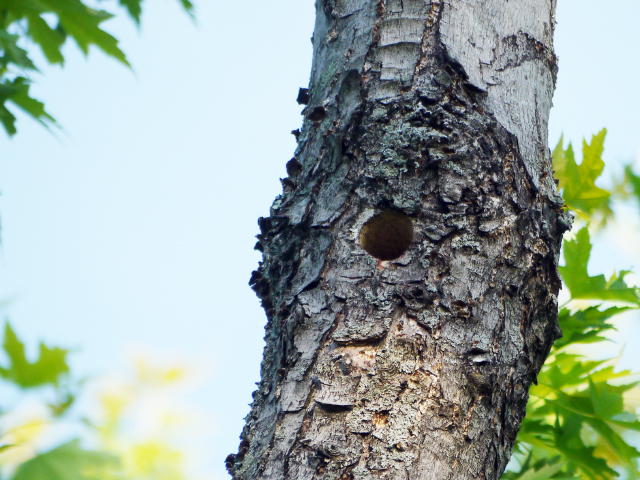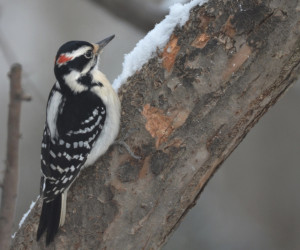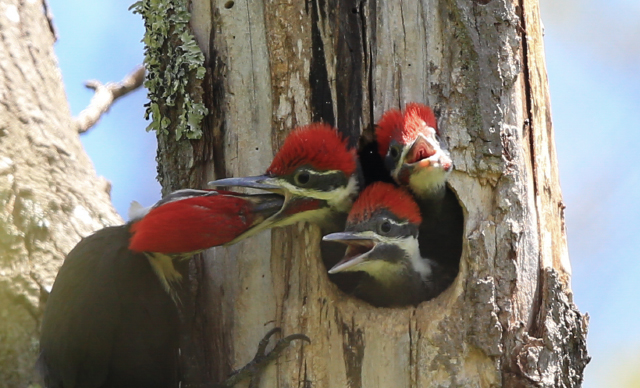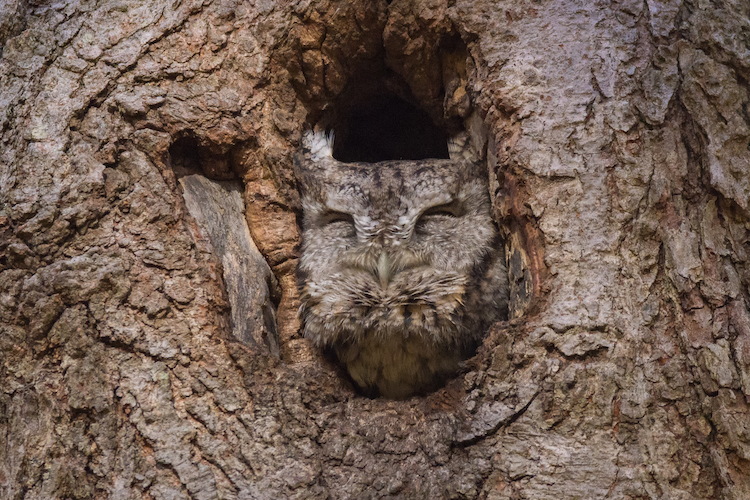As you stop to admire the new leaves on a tree this spring, you may notice holes carved in trunks and branches. Who made these cavities, and why?
Smaller pits may be the work of insects, but most of the larger holes were created by woodpeckers, either for feeding or nesting. Here’s a quick guide to some of their handiwork.

Holes for Feeding
Many woodpeckers carve into trees to find food in the form of insects or sap. Here are some of the species you might see.
Pileated Woodpeckers
Master excavators, these huge birds have chisel-shaped beaks and even feathery tufts over their nostrils to protect them from wood shavings. To get at carpenter ants—their preferred food—they dig deep, rectangular-shaped holes often a foot or more in height. Look for piles of wood chips on the ground below, like the shavings on the floor under a carpenter’s workspace.
Hairy, Downy, and Red-bellied Woodpeckers

Smaller birds typically make smaller holes. Those of hairy woodpeckers are usually no more than ½” wide. These birds tear off bark and drill in search of insects such as beetle larvae, making a wavy pattern as they weave back and forth on a trunk. Downy woodpeckers prefer to probe thinner branches and the stems of reeds. Red-bellied woodpeckers also peck into trees, and are more likely than some other species to store seeds in tree crevices.
Yellow-bellied Sapsuckers

These birds make unmistakable horizontal rows of small holes, often in sugary trees such as maple and birch. Sap collects in these wells, and, true to their name, sapsuckers slurp it up with their brush-like tongues. They don’t just drink tree sap, though. Insects that are attracted to the sugary liquid become a protein-rich meal for yellow-bellied sapsuckers.
Holes for Roosting and Nesting

Woodpeckers also dig deeper cavities for roosting (or resting) and nesting. In order to keep out big predators, they carve entrances that are just large enough for them to come and go. The diameter of an entrance can help you figure out which bird is using it.
A few bird species, such as black-capped chickadees and red-breasted nuthatches, also make shelters in trees. However, they only use dead wood that is relatively soft and easy to carve.
An Important Resource

These excavations aren’t just useful to the woodpeckers. Birds such as eastern screech owls, wrens, and bluebirds need pre-existing cavities for their nests, and they often use woodpecker holes. Flying squirrels and mice shelter in them, too.
The sap-filled wells of sapsuckers are an important food source for mammals, insects, and birds. In particular, ruby-throated hummingbirds rely on them in the early spring, before the flowers have bloomed.
Keep an eye out for holes in trees. Next time you spot one, you may have found a bedroom, a cafeteria, or a nursery!



Unfortunately, there are carpenter ants aplenty in & around my house, which several species of woodpeckers love to dine on. The ants are particularly plentiful in springtime, when they grow wings with which to fly & establish new colonies; then the big pileateds become extra bold about flying right in and feasting upon them, often aggressively chasing the smaller species away to get what they want, FIRST! Sometimes even trying to peck holes in the metal flashing of my roof’s gables! Sounds like a hydraulic jackhammer!! Don’t be surprised to find holes lower on the boles of your trees, because if the holes are there, so is the food the woodpeckers are after: With their keen senses, they can hear & feel even the most minute movement of their quarry, and will relentlessly pursue that prey, wherever it may be.
Hello,
I nam, trying to find out a chain from one species of woodpecker through 5/6 other woodland species who all use the woodpecker hole as secondary cavity users. Can someone help please. What type of tree would I start with i.e. aspen? and which woodpecker ie.e pileated woodpecker and who would use the hole first? A wren? Bluebird? And would it eventually serve a screech owl etc. Any help is gratefully appreciated,
thanks
We just found a large oval hole in our wooden mailbox, we have had a wood box for 30 years, & this is the first time we had anything like this. Our neighbor said she has lately seen the pileated woodpecker in area, so is that the answer to the mystery?
You are probably right – oval holes like this are almost always a sign of Pileated Woodpecker.
Do wood peckers peck near the bottom of a tree?
Those holes are made by Carpenter Bees. If you saw a Woodpecker it’s only because it wants to get inside and eat the Carpenter Bee Larvae. Nom nom nom. Go look up Carpenter Bees…
I have about seven round deep holes (about 2 or 3 inches in diameter) in the trunk of a large cherry tree.
Is there any way to save the tree? The tree is large, about 30-35 feet tall.
I am having the same issue with 3-4 inch holes near the base of the tree. Who would it be and how can I fix it?
Where do I send my pics to?
trying to find out what may be “carving ” openings in side of a tree…several “holes” one as big as a 3 inch oval. the odd thing about this is that th openings are all low on the tree – no higher than 4 feet above the ground. I thought the woodpeckers would do this much higher in a tree……any thoughts if it may be a different creature?
Oval holes sound like Pileated Woodpecker. If you can send photos we can tell for sure. You can email wildlifeinfo at massaudubon.org.
I found holes in a tree on my property. I have a feeling my neighbor did it to kill the tree. How can I find out what or who did the holes?
Hello, I’m having problems with wood peckers making holes in the columns on the front porch of the house. Can you tell me what I can do to try and get them to stop. The columns are not wood. They are made of plaster. Thanks in advance
We have some great suggestions on our website for deterring woodpeckers. http://www.massaudubon.org/learn/nature-wildlife/birds/woodpeckers/situations-solutions
Hi, a neighbor had this issue with their oak and their porch. They used sheets of metal to go around the base of the oak thinking it was squirrels. Needless to say as the oak grove the metal sheets dug into the tree, it cost them $4000 in the end because they killed the tree. Those sheets of metal that they cut to put on their wood with I believe gorilla glue I saved the porch. Needless to say as the oak grew the metal sheets dug into the tree, it cost them $4000 in the end because they killed the tree. Those sheets of metal that they cut to put on their wood with I believe gorilla glue saved the porch.
My neighbor had these issues with their oak tree (proceed with caution) having holes as well as their porch being pecked at/small holes. They attached huge metal sheets from Home Depot to their 75-year-old Oak tree and they also cut some of the metal into strips for their deck and I believe glued or a gorilla tape them to the porch.
As the Oak tree grew the new metal sheets literally grew into the Oaks circumference causing the majesty Oak to die. Not only did it look absolutely ridiculous it killed the Oak and cost the homeowners over $4000 to have the tree taken down.
Side note, the neighbors behind me are completely oblivious to all the holes of varying sizes that are up and down their Oak tree. I love birds can hand feed the Black-capped chickadees (I think this is the 7th generation to come back this year I can also feed one family (yes, female too!) of Red Robins they jump in my hand just like the B.C. Chickadees. But with the wholes I this tree have come what I call the Gangsta birds, We have three Mockingbirds, 5 Huge Bluejays, 6 Massive Ravens, 1 Red Tailed Hawk and the usual Zunco, Wrens and Sparrows. The majority of these birds are living in the tree but fight like crazy over nuts which I feed them!